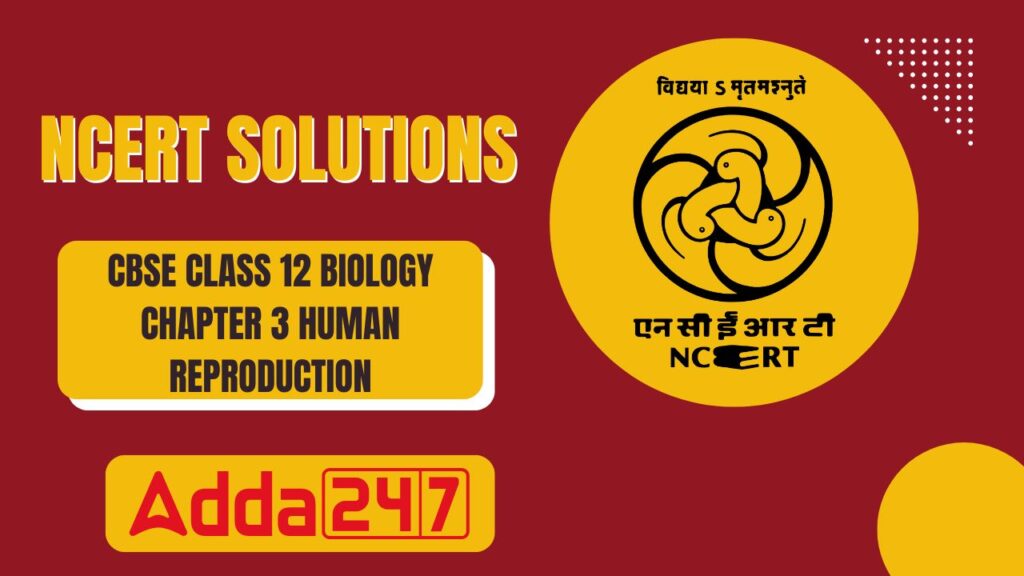
The chapter 3 in the NCERT Class 12 Biology textbook, Human Reproduction, is one of the most important chapters. The study in this chapter revolves around the process of human reproduction, including gametogenesis, fertilization, and the development of the fetus. Some of the major topics that a student covers in the chapter 3 are Gametogenesis, Fertilization, Gestation and Childbirth, Puberty, Reproductive Health, etc.
The students, while studying their Class 12 Biology chapter 3, can now check the answers to all the important questions by scrolling down in the article below.
Overview of CBSE Class 12 Biology Chapter 3
Below we have added the overview of CBSE Class 12 Biology Chapter 3 so that all the aspirants can start their preparations accordingly:
- Male Reproductive System: Structure and functions of testes, accessory ducts, glands, and external genitalia.
- Female Reproductive System: Structure and functions of ovaries, fallopian tubes, uterus, and external genitalia.
- Gametogenesis: Spermatogenesis (formation of sperm) and oogenesis (formation of ova).
- Menstrual Cycle: Phases, hormonal regulation, and significance.
- Fertilization and Implantation: Sperm-egg fusion and attachment of the blastocyst to the uterine wall.
- Embryonic Development: Formation of embryo, placenta, and fetal development.
- Parturition and Lactation: Childbirth and milk production.
- Significance: Understanding human reproduction is crucial for biology, medical entrance exams (e.g., NEET), and reproductive health awareness.
NCERT Solutions for Class 12 Biology Chapter 3 Human Reproduction
To help students complete their preparations for the final examination of the Biology subject in class 12th we have added the NCERT Solutions for Class 12 Biology Chapter 3 Human Reproduction below:
Question 1: Fill in the blanks:
(a) Humans reproduce ________ (asexually/sexually).
(b) Humans are ________ (oviparous, viviparous, ovoviviparous).
(c) Fertilisation is ________ in humans (external/internal).
(d) Male and female gametes are ________ (diploid/haploid).
(e) Zygote is ________ (diploid/haploid).
(f) The process of release of ovum from a mature follicle is called ________.
(g) Ovulation is induced by a hormone called ________.
(h) The fusion of male and female gametes is called ________.
(i) Fertilisation takes place in ________.
(j) Zygote divides to form ________ which is implanted in uterus.
(k) The structure which provides vascular connection between fetus and uterus is called ________.
Answer:
(a) Sexually
(b) Viviparous
(c) Internal
(d) Haploid
(e) Diploid
(f) Ovulation
(g) Luteinising Hormone (LH)
(h) Fertilisation
(i) Fallopian tube
(j) Blastocyst
(k) Placenta
Question 2: Draw a labelled diagram of male reproductive system.
Answer: The male reproductive system consists of organs involved in sperm production, storage, and delivery.
Description of Parts:
- Testes: Paired organs in the scrotum; produce sperm and testosterone.
- Epididymis: Stores and matures sperm.
- Vas Deferens: Transports sperm from epididymis to urethra.
- Seminal Vesicles, Prostate Gland, Bulbourethral Glands: Accessory glands producing seminal fluid.
- Urethra: Conducts sperm and urine (not simultaneously).
- Penis: External genitalia for sperm delivery.
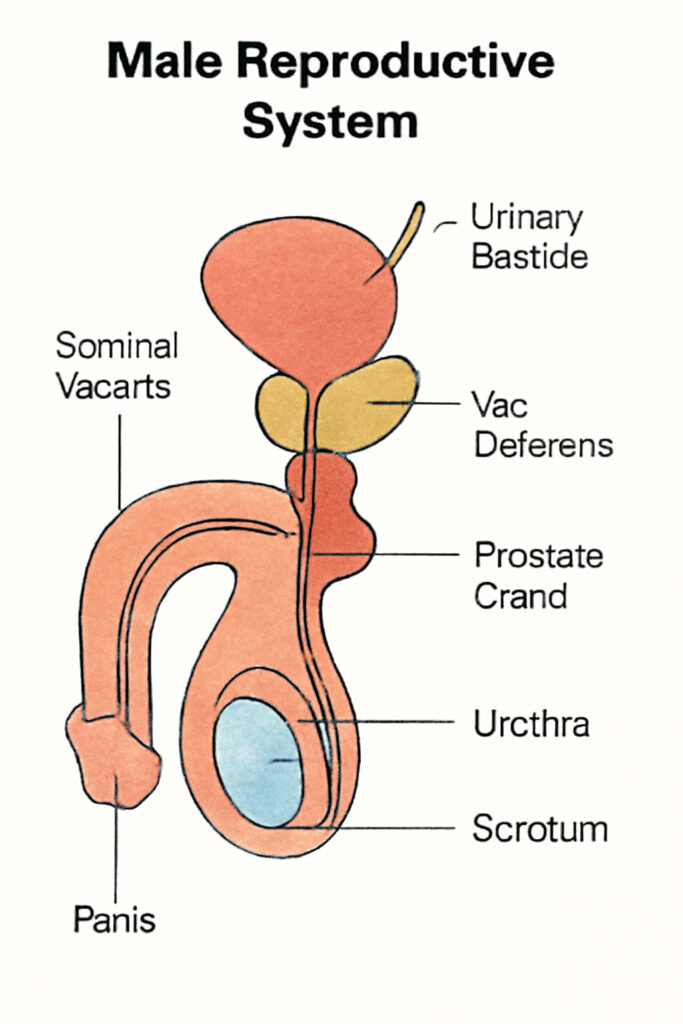
Question 3: Draw a labelled diagram of female reproductive system.
Answer: The female reproductive system is involved in ovum production, fertilization, and fetal development.
Description of Parts:
- Ovaries: Produce ova and hormones (estrogen, progesterone).
- Fallopian Tubes: Site of fertilization; transport ovum to uterus.
- Uterus: Site of implantation and fetal development.
- Cervix: Connects uterus to vagina.
- Vagina: Birth canal and passage for sperm.
- Clitoris and Labia: External genitalia.
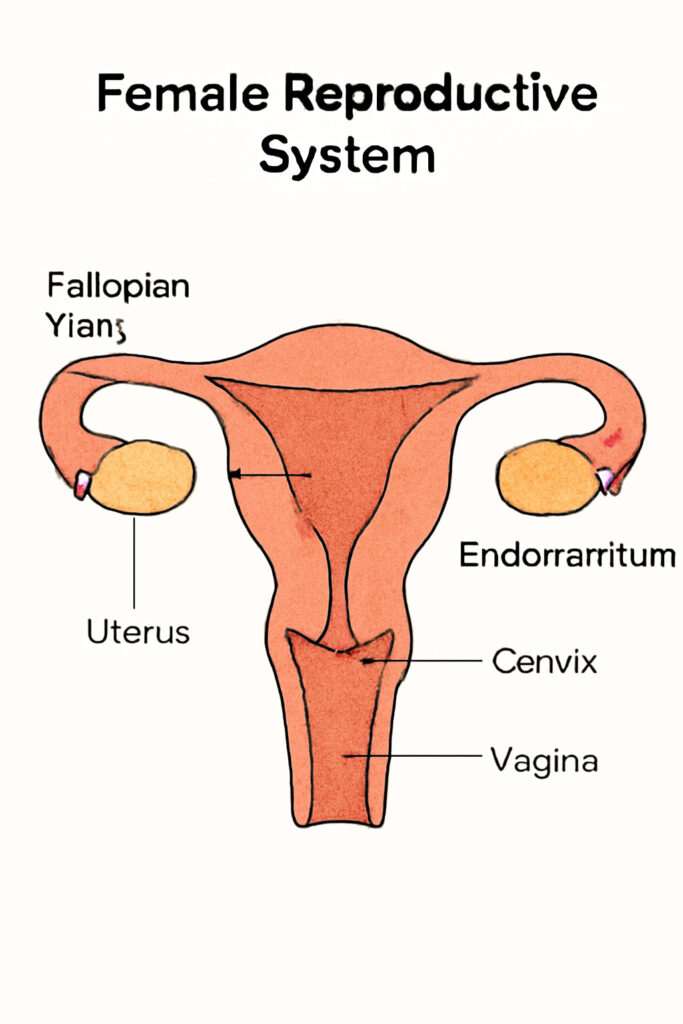
Question 4: Write two major functions each of testis and ovary.
Answer:
- Testis:
- Spermatogenesis: Produces haploid sperm cells in the seminiferous tubules.
- Hormone Production: Secretes testosterone, which regulates male secondary sexual characteristics and spermatogenesis.
- Ovary:
- Oogenesis: Produces haploid ova (eggs) in the ovarian follicles.
- Hormone Production: Secretes estrogen and progesterone, regulating the menstrual cycle and pregnancy.
Question 5: Describe the structure of a seminiferous tubule.
Answer:
- Seminiferous Tubule: A coiled structure in the testes where spermatogenesis occurs.
- Structure:
- Wall: Composed of a multilayered epithelium surrounded by a basement membrane.
- Germ Cells: Include spermatogonia (stem cells), primary and secondary spermatocytes, spermatids, and mature spermatozoa.
- Sertoli Cells: Support and nourish developing sperm cells; form the blood-testis barrier.
- Leydig Cells: Located outside the tubule in interstitial spaces; secrete testosterone.
Function: Site of sperm production through meiosis and spermiogenesis.
Question 6: What is spermatogenesis? Briefly describe the process of spermatogenesis.
Answer:
- Spermatogenesis: The process of sperm formation in the seminiferous tubules of the testes.
- Process:
- Spermatogonia (2n): Diploid stem cells divide mitotically to produce primary spermatocytes.
- Primary Spermatocytes (2n): Undergo meiosis I to form two haploid secondary spermatocytes.
- Secondary Spermatocytes (n): Undergo meiosis II to form four haploid spermatids.
- Spermatids (n): Differentiate into mature spermatozoa through spermiogenesis (development of head, midpiece, and tail).
- Regulation: Controlled by follicle-stimulating hormone (FSH) and testosterone.
- Location: Seminiferous tubules, with Sertoli cells providing nourishment.
Question 7: Name the hormones involved in regulation of spermatogenesis.
Answer: The hormones regulating spermatogenesis are:
- Follicle-Stimulating Hormone (FSH): Secreted by the anterior pituitary; stimulates Sertoli cells to support sperm development.
- Luteinising Hormone (LH): Secreted by the anterior pituitary; stimulates Leydig cells to produce testosterone.
- Testosterone: Secreted by Leydig cells; promotes spermatogenesis and development of male secondary sexual characteristics.
- Gonadotropin-Releasing Hormone (GnRH): Secreted by the hypothalamus; regulates FSH and LH release.
Question 8: Define spermiogenesis and spermiation.
Answer:
- Spermiogenesis: The process by which haploid spermatids transform into mature spermatozoa. It involves:
- Formation of the acrosome (cap-like structure with enzymes).
- Development of a flagellum (tail) for motility.
- Condensation of the nucleus and loss of excess cytoplasm.
Spermiation: The release of mature spermatozoa from Sertoli cells into the lumen of the seminiferous tubule for transport to the epididymis.
Question 9: Draw a labelled diagram of a section through a human seminiferous tubule.
Answer:
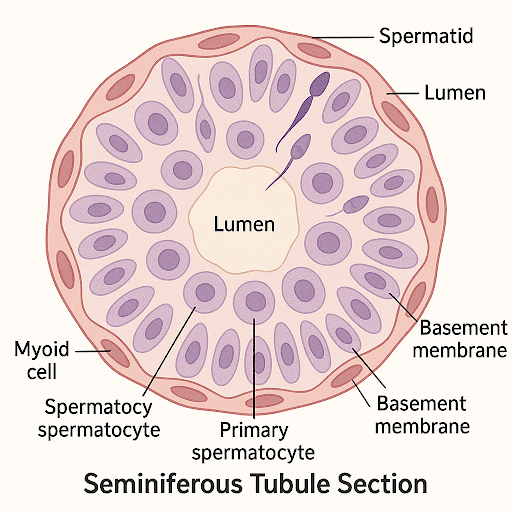
Question 10: What is oogenesis? Give a brief account of oogenesis.
Answer:
- Oogenesis: The process of ovum (egg) formation in the ovaries.
- Process:
- Oogonia (2n): Diploid cells in the fetal ovary divide mitotically to form primary oocytes.
- Primary Oocytes (2n): Enter meiosis I but arrest in prophase I until puberty.
- Puberty: Each menstrual cycle, a primary oocyte completes meiosis I to form one haploid secondary oocyte and one polar body.
- Secondary Oocyte (n): Begins meiosis II but arrests at metaphase II; released during ovulation.
- Fertilization: If fertilized, the secondary oocyte completes meiosis II, forming a mature ovum and a second polar body.
- Location: Occurs in ovarian follicles.
Regulation: Controlled by FSH, LH, estrogen, and progesterone.
Question 11: Draw a labelled diagram of a Graafian follicle.
Answer:
The Graafian follicle is a mature ovarian follicle ready to release an ovum during ovulation.
Description of Parts:
- Oocyte: Secondary oocyte surrounded by the zona pellucida.
- Antrum: Fluid-filled cavity.
- Granulosa Cells: Surround the oocyte and secrete estrogen.
- Theca Layers: Theca interna (hormone-secreting) and theca externa (supportive).
- Cumulus Oophorus: Granulosa cells surrounding the oocyte.
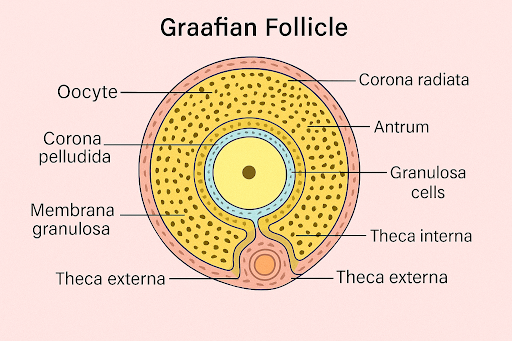
Question 12: Name the functions of the following:
(a) Corpus luteum
(b) Endometrium
(c) Acrosome
(d) Sperm tail
(e) Fimbriae
Answer:
(a) Corpus Luteum: Secretes progesterone, which maintains pregnancy and prevents uterine contractions; also secretes some estrogen.
(b) Endometrium: Inner lining of the uterus; site of blastocyst implantation and supports fetal development during pregnancy.
(c) Acrosome: Cap-like structure on sperm head; contains enzymes (e.g., hyaluronidase) to penetrate the egg’s zona pellucida during fertilization.
(d) Sperm Tail: Flagellum enabling sperm motility to reach the ovum in the fallopian tube.
(e) Fimbriae: Finger-like projections at the end of the fallopian tube; capture the released ovum during ovulation.
Question 13: Name the hypothalamic hormones involved in the regulation of the pituitary hormones that influence the male and female reproductive systems.
Answer: The hypothalamic hormone involved is Gonadotropin-Releasing Hormone (GnRH).
- In Males: GnRH stimulates the anterior pituitary to release FSH and LH, which regulate spermatogenesis and testosterone production.
In Females: GnRH stimulates the release of FSH and LH, which control oogenesis, ovulation, and the menstrual cycle.
Question 14: What is menstrual cycle? Which hormones regulate menstrual cycle?
Answer:
- Menstrual Cycle: A monthly cycle (~28 days) in females involving the preparation of the uterus for pregnancy and shedding of the uterine lining if pregnancy does not occur. It has three phases:
- Menstrual Phase (Day 1–5): Shedding of the endometrium if no fertilization occurs.
- Follicular/Proliferative Phase (Day 6–14): FSH stimulates follicle growth; estrogen rebuilds the endometrium.
- Luteal/Secretory Phase (Day 15–28): Corpus luteum secretes progesterone, preparing the endometrium for implantation.
- Hormones Involved:
- FSH: Stimulates follicle development and estrogen production.
- LH: Triggers ovulation and corpus luteum formation.
- Estrogen: Promotes endometrial growth and secondary sexual characteristics.
- Progesterone: Maintains endometrium and prevents uterine contractions.
Question 15: In our society, women are often blamed for giving birth to daughters. Can you explain why this is not correct?
Answer: Blaming women for giving birth to daughters is scientifically incorrect because:
- Sex Determination: The sex of a baby is determined by the chromosomes contributed by the father’s sperm. Females have XX chromosomes, while males have XY. The ovum always contributes an X chromosome, but the sperm can contribute either an X (resulting in a female, XX) or a Y (resulting in a male, XY).
- Equal Probability: The probability of a sperm carrying an X or Y chromosome is equal (~50%), so the father’s contribution determines the sex, not the mother’s.
- Biological Fact: The mother has no control over the sex of the child, as her gametes are always X.
Question 16: How many eggs are released by a human ovary in a month? How many eggs do you think would have been released if the mother gave birth to identical twins?
Answer:
- Eggs Released in a Month: Typically, a human ovary releases one egg per menstrual cycle (~28 days) during ovulation.
- Identical Twins: Identical (monozygotic) twins result from the division of a single fertilized egg (zygote) into two embryos. Therefore, only one egg is released and fertilized, even in the case of identical twins.
Question 17: How many eggs do you think were released by the ovary of a female dog which gave birth to 6 puppies?
Answer:
- In dogs (which are polytocous), multiple eggs are released during ovulation, and each fertilized egg develops into a puppy.
- If a female dog gave birth to 6 puppies, it indicates that 6 eggs were released and fertilized, assuming each puppy developed from a separate zygote (common in dogs, as they typically produce non-identical offspring).














